








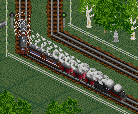





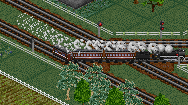
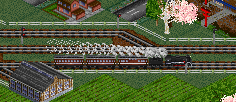














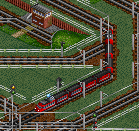





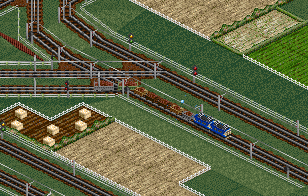
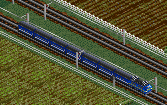

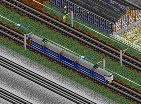
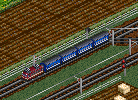


Ahh yes, the trains. We offer here a list of the trains included in the Japan Railways set.
9600   | The 9600 was designed in 1913, but saw service for decades thereafter; 770 were manufactured. It was the first real success in locomotive building in Japan; prior to the 9600, most locomotives were manufactured elsewhere and imported. The 9600 was so well-fitted to the social and technical environment that it was used until the very end of Japanese steam. |
|---|---|
8620   | Designed in 1914, the 8620 also was in use until very late in the steam era, because its relatively light weight and high power allowed it to operate on less-high-quality track where the more powerful, but heavier, C53 or C59 couldn't safely go. |
ED17  | A generic name for various imported passenger locomotives that have been remodelled for freight service. |
D50 | |
C53 | Japan National Railways imported 6 three-cylinder locos from the United States for experimentation; as a result of this experiment, the C53 was developed as a fast express locomotive. Unfortunately the complexities of having three cylinders made it uneconomic; it required maintenance of a much higher level than was easily provided. The C59 was designed to replace it, using the simpler two-cylinder mechanism, but WW2 locomotive shortages bought the C53 a new lease on life until the war ended. |
| C11 | The C11 is a tank engine frequently used for suburban passenger runs, as well as for light freight. British Rail and its predecessors also used tank engines in a similar ecological niche for commuter services around London. |
C12 | Even lighter than the C11, the C12 was designed for use on extremely cheap and poor quality rail lines, due to the Great Depression and lack of investment capital. It would be similar in service to the "Stepney" Terrier tank loco used in Great Britain. |
Class 40 EMU | |
EF10 | Standard freight loco before WW2. Some copies of the class had a body of stainless steel for use in underwater tunnels, where ordinary steel would quickly corrode in the damp conditions. |
| D51 | |
EF55 | The EF55 was a streamlined electric locomotive, made with the Art Deco styling of the era (or at least, the Japanese interpretion of Art Deco.) Although it is intended to go in one direction, there is a minimal cab at the opposite end for short distance and yard use. |
C57  | A standard express model for semi-major lines. Nicknamed "Noble Lady" because of its well-balanced and beautiful form. |
C58 | Mid-sized locomotive apt both for passenger and freight. |
D52 | Developed to haul heavy coal drags on the railways, as WW2 made transporting coal by ship too risky. |
EF58 | A very significant express passenger locomotive, only replaced by EF65. |
C62 | Fabricated using the boiler of D52 which had become superfluous with the end of the war. The heaviest steam engine ever used in Japan. |
E10 | Used as helper locomotive at steep mountain slopes. |
Class 80 EMU  | The first long-distance EMU. Before, JNR's long-distance passenger services were done by hauled trains like in any other country; after this JNR tended to serve long distance services with EMU and DMU trainsets. |
EH10 | |
DF50 | Diesel-electric loco using engines imported from Germany. Designed to replace C57 and D51 steam engines. Its insufficient performance pushed JNR to develop the higher-power diesel-hydraulic DD51. |
Class 151 Express EMU  | Express model designed for the service between Tokyo and Osaka. Its technological success prepared the way for the Shinkansen bullet trains. |
KIHA 82 DMU | First put into services from Tokyo northward, then seen everywhere in the country, as in the 1960's there were still many non-electrified mainlines in Japan. |
DD51  | The JNR opted to develop this high-performance diesel-hydraulic loco rather than to improve the track to allow heavier diesel-electrics. This is probably the same reason why Japan's rail systems have such massive recourse to EMUs and DMUs rather than loco-hauled trains for express services - EMUs and DMUs are indidivually lighter than one powerful locomotive. |
Class 115 "Semi-Fast" EMU | Suburban train. Massively used all over the islands along with mechanical variants, in all manner of liveries. |
Odakyu "Romance" 3100 EMU  | Odakyu is a private rail company operating from Tokyo southwestward. These are panoramic trains from Tokyo to Hakone (a touristic site around 80 km away Tokyo). Having bogies between wagons like the Talgo and TGV, and with a low centre of gravity, these trains are able to travel on the twisting curves of the scenic route at a high speed, without having tilting ability. |
EF64  | Standard model for the hilly terrain. Especially seen on the inland lines between Tokyo and Nagoya, and between Tokyo and Niigata. |
"0" Series Shinkansen  | The first version of the famous "bullet train", the Shinkansen. |
EF65 | The standard locomotive for DC electrification. Of course, TTD doesn't distinguish electrification types, so it can be used along with the rest. |
| DE10 | Diesel-hydraulic locomotive for secondary lines. with a very low weight and just sufficient power for the purpose. In a sense, successor of the C11 and C12 tank engines. |
EF66  | Express freight on the corridor Tokyo-Nagoya-Osaka to the west-end of the mainland. Used also for hauling night trains since mid-1980s. |
Class 583 Express EMU | Sleeper EMU. At this time the JNR had an urgent need to increase the number of passenger carriages due to increasing traffic, yet they didn't have any more room in the garaging yards during the night. The solution was an EMU apt both for day- and night-services. First put into service from Osaka westward, then a couple of years later also from Tokyo northward. Also this type is the first to adopt the flat face of cab-car that became the standard design of Japanese express EMUs for some time. |
EF81 | Can run under 1500 V DC, 2 kV AC (50 and 60 Hz). Used in the coastal corridor Osaka-Niigata-Akita. |
Class 183 Express EMU | Updated version of the Class 151. |
KIHA 66 DMU | Developed to improve the transport around the Fukuoka area, which was the new terminal of the Shinkansen. The interior was later adopted into the class 117 EMU, predecessor of the 223 EMU. |
| "100" Series Shinkansen | 57 sets, with several two-story carriages. This class aimed at improved comfort, and double-decks carriages had restraurant or the first-class coach at the high level and compartments in the lower level. These are now vanishing due to the goal of higher operating speeds, because the double-deck carriages limit the top speed. |
| Odakyu "Romance" 10000 EMU | Updated version of the "Romance" 3100. |
| EF200 | Intended as a replacement for the aging EF66, unfortunately its high consumption of electricity caused some troubles and actually resulted in a similar performance, but higher expenses, than EF66s. |
| "300" Series Shinkansen | This opened a new era of the Shinkansen express service between Tokyo and Osaka, with operating speeds of 270 km/h. |
| KIHA 120 DMU | Light diesel car for minor lines. |
| DF200 | Diesel-electric locomotive used in Hokkaido island (the northern piece of Japan) for freight services. |
| E351 Express EMU | Tilting train operating around Tokyo. |
| KIHA 281 DMU | Tilting train operating in the northern regions. |
| Class 223 EMU | Fast and frequent service between Kyoto and Osaka. |
| EH500 | Successor of the EF81, this is designed for heavy freight. |
| E231 EMU | Suburban train around Tokyo. The latest version of "disposable" train that starts with the class 209. |
| "E4 Max" Shinkansen | Double-deck commuter Shinkansen. The duckbill-like beak reduces the wind-shock on entering tunnels, of which there are very many. |
| "500" Series Shinkansen | Runs at 270 km/h between Tokyo and Osaka, at 300 km/h from Osaka westward. |